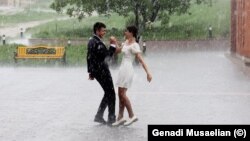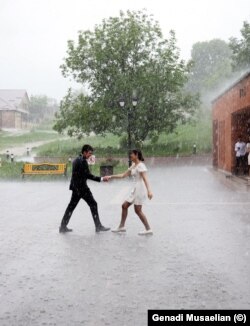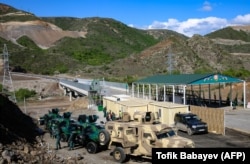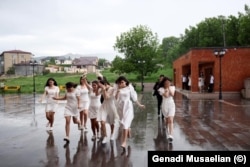Amid fears for the future of ethnic Armenians in Nagorno-Karabakh, two teenagers have become a symbol of resolve as bitter political talks over the region continue.
When a rainstorm burst over their high-school graduation ceremony in Stepanakert on May 26, Karen Galstian and his classmate Ani thought nothing of dashing into the downpour to dance.
"At first, it seemed to us something ordinary. Why not? It’s just a bit of mischief," Galstian told RFE/RL. "Everything looked so beautiful that I wanted to dance."
But in the context of increasing anxiety among Armenians over the future of the Nagorno-Karabakh region, the dance quickly became seen as an emblem.
When the images began to be shared across social media, Galstian, who uses the Armenian word Artsakh for the Nagorno-Karabakh region, recalls, "I realized that these few moments were enough to describe the unbending will and love of us, the young generation of Artsakh, for our restless Artsakh land."
Armenia and Azerbaijan have fought over Nagorno-Karabakh for decades. A war in the 1990s left ethnic Armenians in control of the Azerbaijani region, which has had a predominantly Armenian population for centuries, as well as swaths of Azerbaijani land outside Nagorno-Karabakh.
Conflict over the region again erupted into full-scale war in 2020, when Azerbaijan launched an attempt to retake the region by force. That war ended with an Armenian defeat and a Moscow-brokered cease-fire that led to some 2,000 Russian troops being deployed into the region as peacekeepers.
An ongoing Azerbaijani blockade of the Lachin Corridor, the only road from Armenia into Nagorno-Karabakh, has led Yerevan to accuse Moscow of not fulfilling its obligations under the treaty. In April 2023, an Azerbaijani checkpoint was installed on the same road. Locals say Russian troops "stood by and did nothing" as its construction took place.
A recent report by the International Crisis Group said that, while the checkpoint is a relatively small step, the 120,000 ethnic Armenians in Nagorno-Karabakh worry it "represents a form of muscle flexing that could be the precursor to ethnic cleansing."
Recent Russian-mediated talks between the Armenian and Azerbaijani leadership have led to Baku and Moscow claiming that a peace settlement is likely to be announced soon, but Armenian Prime Minister Nikol Pashinian told his parliament on May 29 that an agreement remained out of reach.
Pashinian has indicated he is willing to acknowledge Azerbaijani sovereignty over the Nagorno-Karabakh region provided the security of ethnic Armenians in the region is guaranteed. Baku says ethnic Armenians would have the same rights as any other inhabitants of Azerbaijan. But several brutal murders of ethnic Armenians blamed on Azerbaijani soldiers has left some observers fearing the worst if control of the region is handed back to Baku.
For the thousands of Armenians who viewed the dance of two high-school students as rain hammered down around them, the scene was as bittersweet as it was cinematic, with some calling it a "final last bell." High-school graduation is known in Armenian as the "last bell."
Narine Avanesian Gabrielian, who posted a video of the dance that was shared more than 1,200 times on Facebook, told RFE/RL, "It felt like the moment was from a beautiful movie," adding that, for Armenians, life itself in the embattled region is seen as a kind of resistance.
The teenage dancers, she said, "remind the world that they are determined to live on their ancestral land. It's another way of fighting."



